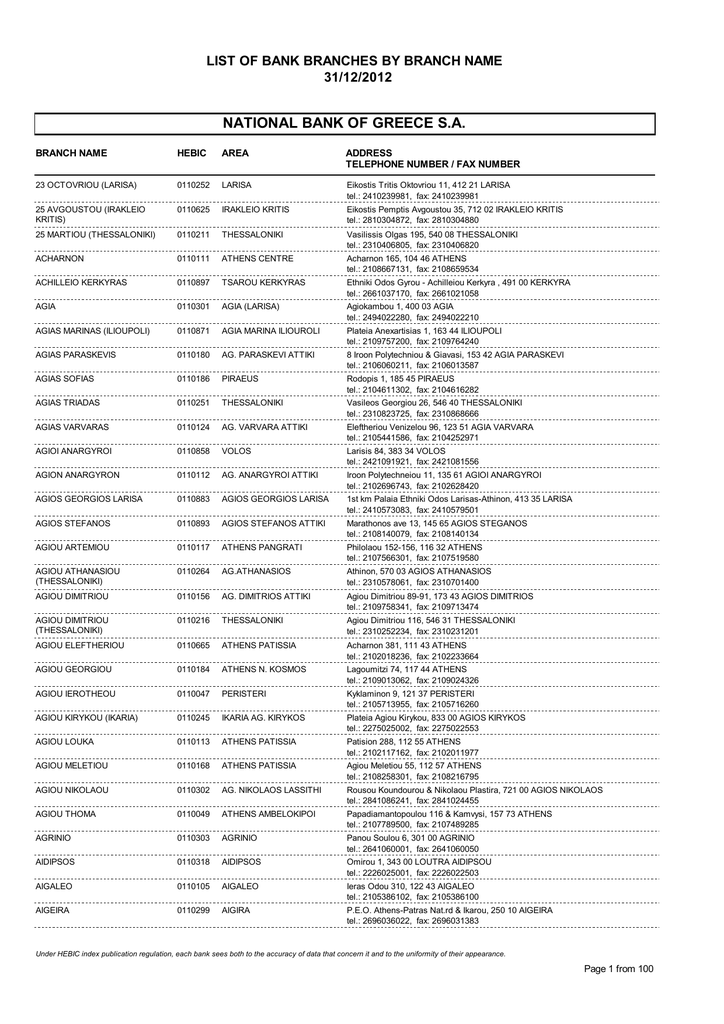
National Bank Ag Germany Bank Profile
National Bank Essen Online Banking
Nationalbank Ag Werbegemeinschaft Innenstadt
National Bank Essen Online Banking
Oesterreichische Nationalbank Ag Oenb Austrian National Bank Stock
National Bank Ag Essen Germany
Agriculture First Dakota National Bank
Wolfsberg Questionnaire National Bank Ag
Firmenkundenbetreuer W M D Job Bei National Bank Ag In
How To Get To Punjab National Bank 102 Block Ag Sanjay Gandhi
Old National Bank On Twitter Old National Bank Is Dedicated To
Agriculture Ag Loans From Litchfield National Bank
Vienna Oesterreichische Nationalbank Ag Oenb National Bank Of
National Bank Ag Financial Times
Wien Vienna Oesterreichische Nationalbank Ag Oenb Austrian
National Bank Ag Essen Bank Facebook
Wolfsberg Questionnaire National Bank Ag
Top Punjab National Bank Atms In Hinoo Ranchi Justdial
Ag Banking Agriculture First Dakota National Bank
Atos Secures Contract With National Bank Ag Dcd
National Bank Of Uzbekistan And Germany S Deutsche Bank Ag Sign A
Datei National Bank Ag Essen 1942 Jpg Wikipedia
Ag Lending Farmers Merchants National Bank
60 Top National Bank Ag Pictures Photos Images Getty Images
Commercial Loans Auto Loans Mortgage Loans Ag Loans Student
The National Bank Of Ukraine Approved The Deal Between Abh Holdings
Bidspirit Auction Germaniya National Bank A G
60 Top National Bank Ag Pictures Photos Images Getty Images
First National Bank Of Omaha Personal Business Banking And Insights
Central National Bank Announces New Lending Services Office For
Oesterreichische Nationalbank Ag Oenb Austrian National Bank Stock
Viewers Choice Awards Amarillo National Bank Wins Best Ag Lender
Newsroom Future Of Agribusiness Survey First National Bank Of Omaha
Welcome To Valley National Bank Answers To Important Questions
Ag Deposits And Investments Agriculture First Dakota National Bank
National Bank Ag Woeste Druck Verlag Gmbh Co Kg
National Bank National Bank Ag Begrusst Neue Auszubildende
Ag Sues Westport National Bank Wilton Man In Madoff Case Westport
Ag Real Estate First National Bank In Tremont Illinois
Oesterreichische Nationalbank Ag Oenb Austrian National Bank Stock
For All Your Banking Needs Greenville National Bank Greenville Oh
Agriculture First Dakota National Bank
First National Bank Fnbbal Twitter
Website Of The National Bank Of Liechtenstein Editorial Stock Photo
I Want A New Tommy Gun And The Floor Plan Of The First National Bank
Punjab National Bank Pnb Surera Teh Etmadpur Distt Ag Branch Agra
Importakkreditive Satzaufbau National Bank
Deutsche Bank S Turnaround Plant Hit By Weaker German Economy The
National Bank Ag Essen Bank Facebook
Country Wise List Of Our Foreign Correspondents Sonali Bank Limited
Sauk Valley Media Business Directory Coupons Restaurants
Community National Bank And Trust Home
Details About 1934 National Bank Of Scotland Limited 1 Banknote A G 242 049 First Vf
Experienced Farmers And Ag Legends Producing Results Together Lcnb
Wolfsberg Questionnaire National Bank Ag
Swiss National Bank In Berne Switzerland At The Bundesplatz Stock
Agricultural Loan Land Financing Ephrata National Bank
Commercial Loans Auto Loans Mortgage Loans Ag Loans Student
First National Bank Ws Ag Center
Pnb Indore Armb Ifsc Code Punb0688500
Kazakh National Bank Issues New Gold And Silver Coins The Astana Times
National Bank Shakes Up Its Dividend All Stars Portfolio The Globe
Wolfsberg Questionnaire National Bank Ag
Agriculture Takes Center Stage At New First National Bank Branch
Increase In Loan Portfolio Of Banks National Bank Of Greece Efg
Nationalbank Auf Dem Holzweg Informer Online
The Safe Act First National Bank Creston Iowa
About Us Bradford National Bank
National Bank Velbert Die Bank Fur Anspruchsvolle Kunden
Circuit Court Of The District Of New Hampshire October Term 1886
National Bank Ag Financial Times
National Bank Ag Essen Germany
National Bank Wirtschaftsvereinigung Steinfurt E V
Vorstandsmitglied Der National Bank Ag Essenportrat News Photo




